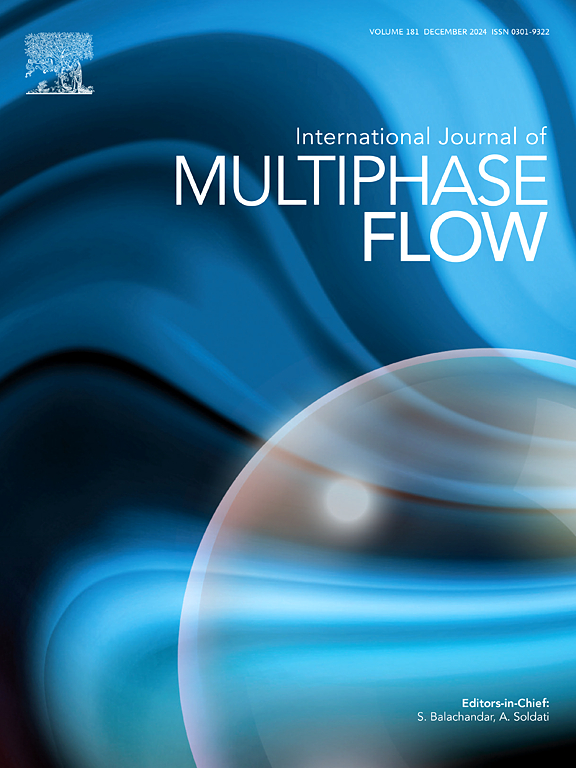IF 3.6
2区 工程技术
Q1 MECHANICS
International Journal of Multiphase Flow
Pub Date : 2025-01-28
DOI:10.1016/j.ijmultiphaseflow.2025.105156
引用次数: 0
摘要
由于过去十年中塑料降解过程的加剧,人类可能会接触到室内和室外的微塑料。当吸入时,这些微塑料会导致炎症和呼吸系统疾病。最近的研究提高了我们对呼吸系统中微塑料运输的理解;然而,他们往往忽略了各种呼吸模式,颗粒形状的影响和特定的积聚模式在气管支气管。这项研究独特地调查了不同形状的微塑料是如何在不同的呼吸流速和频率下积累的,为它们在这些关键气道中的行为提供了新的见解。结果表明:在低流速为7.5 LPM、循环频率为0.5 Hz时,微塑性沉积最小,但当频率降至0.25 Hz时,微塑性沉积显著增加,特别是在主支气管;较高的吸入流速,如40lpm,会导致气管支气管早期几代(包括1-8代)的微塑料沉积更大,在吸入和呼出阶段之间存在显著差异。在第8代之后,较小的流速导致远端气道中较高的微塑性沉积。右支气管吸入微塑料的风险较高,大颗粒(4 ~ 10 μm)在低流速下更多地沉积在主支气管,小颗粒(1 ~ 3 μm)在高流速下更多地沉积在初始气道。这项研究的结果,包括特定病例的微塑料沉积热点,将有助于了解污染物暴露和相关预防措施的最新知识。本文章由计算机程序翻译,如有差异,请以英文原文为准。

Breath of pollutants: How breathing patterns influence microplastic accumulation in the human lung
Humans are likely exposed to indoor and outdoor microplastics due to increased plastic degradation processes in the last decade. When inhaled, these microplastics could lead to inflammatory and respiratory disorders. Recent studies have advanced our understanding of microplastic transport in the respiratory system; however, they often overlook the various breathing patterns, effects of particle shape and specific accumulation patterns in the tracheobronchial airways. This study uniquely investigates how microplastics of various shapes accumulate under different breathing flow rates and frequencies, providing new insights into their behavior within these critical airways. The key findings show that microplastic deposition is minimal at a low flow rate of 7.5 LPM and a cycle frequency of 0.5 Hz but increases significantly when the frequency drops to 0.25 Hz, especially in the main bronchus. Higher inhalation flow rates, such as 40 LPM, lead to greater microplastic deposition in the early generations of the tracheobronchial airways, including generations 1–8, with notable differences between the inhalation and exhalation phases. Smaller flow rates result in higher microplastic deposition in distal airways beyond generation 8. The risk of microplastic inhalation is higher in the right bronchi, with larger particles (4–10 ) depositing more in the main bronchi at lower flow rates and smaller particles (1–3 ) in the initial airways at higher flow rates. The findings of this study, including case-specific microplastic deposition hotspots, will contribute to the up-to-date knowledge on pollutant exposure and relevant preventive measures.
求助全文
通过发布文献求助,成功后即可免费获取论文全文。
去求助
来源期刊
CiteScore
7.30
自引率
10.50%
发文量
244
审稿时长
4 months
期刊介绍:
The International Journal of Multiphase Flow publishes analytical, numerical and experimental articles of lasting interest. The scope of the journal includes all aspects of mass, momentum and energy exchange phenomena among different phases such as occur in disperse flows, gas–liquid and liquid–liquid flows, flows in porous media, boiling, granular flows and others.
The journal publishes full papers, brief communications and conference announcements.

 求助内容:
求助内容: 应助结果提醒方式:
应助结果提醒方式:


